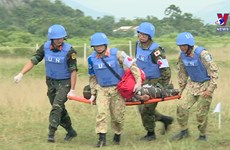Hanoi responds to International Thalassaemia Day
A meeting themed “Joining hands for thalassaemia patients” was held in
Hanoi on May 8 to respond to the International Thalassaemia Day (May 8).
A meeting themed “Joining hands for thalassaemia patients” was held in
Hanoi on May 8 to respond to the International Thalassaemia Day (May 8).
It aimed to raise public awareness of the disease, providing information on how it is transmitted and ways to stay healthy.
Thalassaemia basically means anemia, a genetic blood disease which the child could inherit if one or both of his/her parents carry the disease gene. The risk is higher if both parents have this disease. Symptoms are not visible, but it can be identified through medical tests.
About 7 percent of the world population have thalassaemia gene. Vietnam is among high risk areas with more than 5.3 million people carrying the gene and more than 20,000 fatal thalassaemia patients that need treatment.
About 2,000 Vietnamese children are born with the disease every year.
This year, the International Thalassaemia Day, themed "Economic Recession: Observe – Joint Forces – Safeguard Health," underscores the need to support decisions and policies that look to reduce inequality in accessing health care services, especially in countries hard hit by economic and financial recession.
According to Prof. Dr. Nguyen Anh Tri, head of the Central Heamatology and Blood Transmission Hospital, without prevention and treatment measures, t halassaemia will affect the quality of population.-VNA
It aimed to raise public awareness of the disease, providing information on how it is transmitted and ways to stay healthy.
Thalassaemia basically means anemia, a genetic blood disease which the child could inherit if one or both of his/her parents carry the disease gene. The risk is higher if both parents have this disease. Symptoms are not visible, but it can be identified through medical tests.
About 7 percent of the world population have thalassaemia gene. Vietnam is among high risk areas with more than 5.3 million people carrying the gene and more than 20,000 fatal thalassaemia patients that need treatment.
About 2,000 Vietnamese children are born with the disease every year.
This year, the International Thalassaemia Day, themed "Economic Recession: Observe – Joint Forces – Safeguard Health," underscores the need to support decisions and policies that look to reduce inequality in accessing health care services, especially in countries hard hit by economic and financial recession.
According to Prof. Dr. Nguyen Anh Tri, head of the Central Heamatology and Blood Transmission Hospital, without prevention and treatment measures, t halassaemia will affect the quality of population.-VNA













